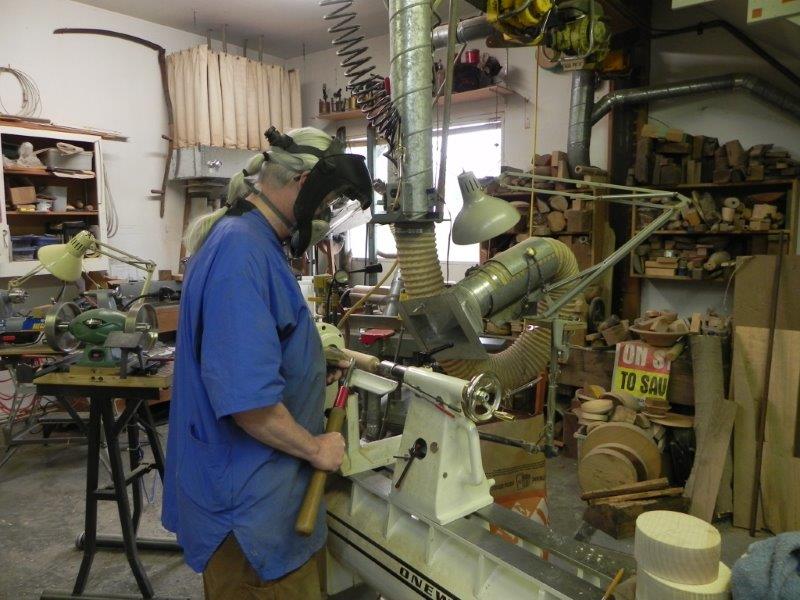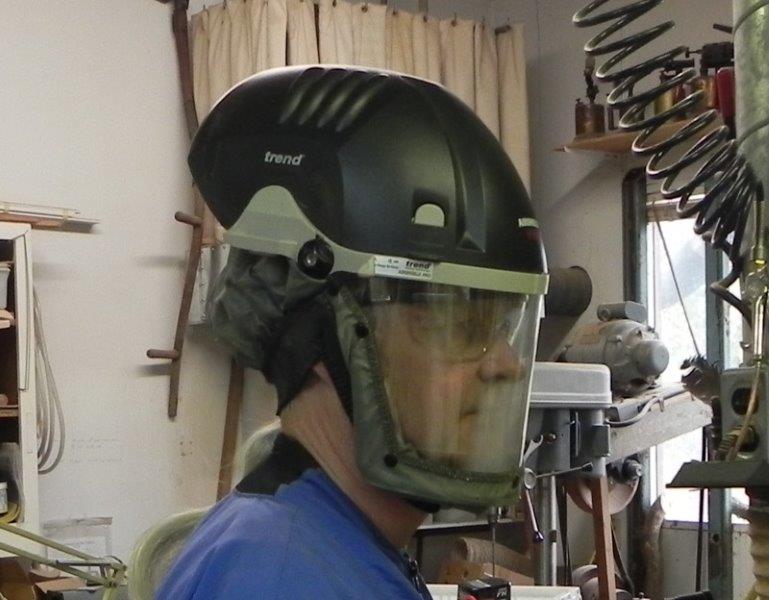Originally written by Ed for Craftsy as “Safety at the Lathe: Woodturning Safety Tips”>
It’s the only machine tool in the shop where the machine moves the wood and the cutting tool is held by the operator. The lathe, therefore, has its own unique safety considerations besides all the other risks that are ever-present in any shop. Observing some basic woodturning safety rules will make your time at the lathe far more enjoyable.

Wood rotating on a lathe can catch loose clothing and hair in its grasp in a heartbeat.
For simplicity, most guidelines for woodturning safety fall into three main categories: protection from entanglement; protection for the eyes, face and body; and respiratory protection. Of course there are myriad other operational considerations so for detailed guidelines, visit this website to view the American Association of Woodturners Safety Guidelines.

A woodturner using all the protective gear and precautions noted in this post.
Protection from entanglement
While it is possible to become entangled in other woodworking machinery, the danger is heightened at the lathe. Your hands, body and clothing are closer to the hazard and the diameter and irregularity of the wood itself has a greater tendency to “grab” anything long and loose. Once clothing, hair or hanging jewelry become entangled in the wood, severe injury occurs in a microsecond.
- Clothing should be close fitting without being restrictive.
- While close fitting cuffs on sleeves are acceptable, short sleeves eliminate any possibility of having your arm wrapped into the spinning wood.
- Long hair is very easily drawn into the spinning wood so must be tied back into a ponytail or bun.
- Hanging jewelry should be removed completely. Tight fitting watches and rings are less of an issue but removing them removes the problem.
Eye, face and body protection
Eye protection is always a must but depending on the cut, the lathe can shower the operator with shavings directly in the face with considerable force. Because of that, safety glasses alone are not enough. A face shield not only more than doubles the protection provided by the safety glasses, it eliminates the painful shower of chips in the face.
More importantly, the face shield provides some protection from the work piece itself. The centrifugal force when the wood is spinning at high speed is tremendous, causing loose bark to fly off and cracked wood to separate or break up entirely. People have been severely injured and even killed in these situations. For that reason, a simple splash shield is not enough. Suitable face shields for woodturning should be strong and fit well so that they are not easily dislodged.
Eliminate the problem as much as possible by not turning questionable wood. Cracks can be quite artistic but not at the expense of serious injury.
You should be fully clothed with decent footwear. Turning in shorts with no shirt is akin to frying bacon in the same getup. Loose fitting gloves can get caught easily but a close-fitting, fingerless glove on the hand closest to the work when doing heavy roughing will prevent the solid stream of chips from abrading the skin of your hand.
Hearing protection is a must like any other machine tool. Earplugs are often more suitable than muffs because of all the other protective equipment that must be worn.
Respiratory protection
Respiratory protection in the wood shop at large is of extreme importance. At the lathe, much like eye protection, the hazard is super-sized. The moving wood tends to create its own “wind”, making it very difficult or sometimes impossible to control the dust that comes off the work when turning or sanding.
The most effective measure is to control the dust at the source with a high-volume dust control system. Should you be fortunate enough to have a good dust control system, you should still wear a good half-face respirator at all times while turning.
If you have to think about it, do it.
It’s fair to say that it’s impossible to note every single hazard in every situation. I worked as a firefighter for 36 years and encountered many situations not covered in the textbook. The one piece of advice that an old hand passed on to me early in the game was, “If you have to think about, you better do it.” In other words, if your sixth sense caused you to wonder if something might be unsafe – it’s unsafe and you need to deal with it. Trust your instincts.

